Tüsterî’den (Ö.283) Konevî’ye (Ö.673) İşârî Fatiha Yorumları: Tefsir’den Müşâhede Yöntemine Yorumlamanın Seyri
Öz
Hz. Peygamber’le başlayan, züht ve takvâ nitelikli tasavvufî/işârî
yorumlar tefsir ilminin gelişmesine paralel olarak nitelik ve nicelik yönden değişmiştir. Şifâhi
gelenekle aktarılan işârî yorumlar Tüsterî’yle birlikte müstakil tefsirler
içinde vücud bulmaya başlamışsa da Tüsterî’nin Fatiha tefsirinde bu yön öne
çıkmamıştır. Sülemî ile devam eden süreçte sûfî amelî yorumlardan oluşan işârî
tefsir, Kuşeyrî’de zâhir ve bâtın çelişmezliği üzerine bina edilen amelî te’ville
varlığını sürdürmüş, Gazâlî’de Hikmet arayışlarına yönelmiş, Ruzbihân Baklî ile
Kurân’ın letâif hazinelerinin ortaya çıkarılması amaçlanmış, Dâye ile harflere
anlam libası giydirilmiş, sıfatlarla ilişki kurulmuş, İbn Arâbî
ile bu ilişki insan-varlık-Tanrı münasebetine dönüştürülmüş, sembolik bir dil
ile bu münasebet açıklanmış, Konevî ile de
bu süreç sonraki nesillere taşınmıştır. Netice itibariyle Fatihâ
yorumları bu süreçte tefsirden müşahede yöntemine doğru ilerlemiştir. Çalışmamızda Tefsir Edebiyatında Tüsterî’den Konevi’ye kadar Fatiha Süresinin işarî
yorum bağlamında uğradığı değişimlere değinilecektir.
Kaynakça
- Ahmed b. Muhammed El-Ednevî. Tabakâtü’l-Müfessirîn. Thk. Süleyman b. Salih el-Huzey. 1. Bs. es-Suûdiyye: Mektebetü’l-Ulûm ve’l-Hükm, 1997.
- Ebû Ca’fer et-Taberî. Camiu’l-Beyân an Te’vîli’l-Kur’ân. Thk. Ahmet Muhammed Şakir. ys.: Müessesetü’r-Risâle, 2000.
- Ebû Hamid Muhammed el-Gazali et-Tûsî. Cevâhiru’l-Kur’ân. Thk. Muhammed Reşid Rıza el-Kabânî. Beyrut: Daru’l-İhyâi’l-Ulûm, 1986.
- Ebû Hamid Muhammed el-Gazali et-Tûsî. İhyâ-i Ülûmi’d-Dîn. Beyrut: Dâru’l-Marife, ts.
- Ebû Muhammed Sehl. Tefsîr-i Tüsterî. Thk. Muhammed Basil Uyun. Beyrut: Dâru’l-Kütübi’l-İlmiyye, 1423.
- El-Kuşeyrî. et-Teysîr fî ilmi’t-Tefsir. Thk. Abdullah b. Ali el-Meymûnî el-Mutayrî. ys., 1427.
- El-Kuşeyrî. Letâifu’l-işârat. Trc. Mehmet Yalar. 1. Bs. İstanbul: İlk Harf, 2012.
- El-Kuşeyrî. Letâifü’l-İşârât. Thk. İbrahim Besyûnî. 3. Bs. Mısır: Heyetü’l-Mısrıyye el-Amme li’l-Kitab, ts.
- er-Ragıp El-İsfehânî. el-Müfredât fî Garîbi’l-Kur’ân. Thk. Safvan Adnan ed-Dâvudî. Dımeşk Beyrut: Daru’l-Kalem Daru’ş-Şamiyye, 1412.
- es-Safedî. el-Vâfî bi’l-Vefâyât. Thk. Ahmed Arnavud Türkî Mustafa. Daru’l-İhyâi’t-Türâs, 2000.
- Ez-Zehebî. Siyer-i A’lâmi’n-Nübelâ. 3. Bs. ys.: Müessesetü’r-Risâle, 1985.
- Ez-Zemahşerî. el-Keşşâf an Hakâiki Gavâmidi’t-Tenzîl. Beyrut: Dâru’l-Kütübi’l-Arabî, 1407.
- Fahreddin er-Râzî. Mefâtihu’l-Gayb. ys.: Daru’l-ihyâi’t-Türâsi’l-Arâbiyyi, 1440.
- Hacı Halife. Keşfi’z-Zunûn. Bağdat: Mektebetü’l-Müsennâ, 1941.
- Hamid Algar. “Necmeddin-i Kübrâ”. TDV. İslam Ansiklopedisi. İstanbul: TDV İslam Araştırmaları Merkezi, 2006. https://islamansiklopedisi.org.tr/necmeddin-i-kubra#1.
- İbn Nedîm. el-Fihrist. Thk. İbrahim Ramazan. 2. Bs. ys.: Daru’l-Marife, 1997.
- Maturîdî. Te’vîlât-i Ehli’s-Sünne. Thk. Mecdî Bâslûm. Beyrut, Lübnan: Daru’l-Kütübi’l-İlmiyye, 2005.
- Mehmet okuyan. Necmuddin Dâye ve Tasavvufî Tefsiri. Doktora, OMÜ, t.y.
- Muhammed es-Seyyid Huseyn Ez-Zehebî. et-Tefsîr ve’l-Müfessirun. Kahire: Mektebetü Vehbe, ts.
- Necmüddin Kübrâ. et-Te’vîlâtü’n- Necmiyye. Thk. Ahmed Ferîd el-Mezîdî. 1. Bs. Beyrut, Lübnan: Dâru’l-Kütübi’l-İlmiyye, 2009.
- Ruzbihân Baklî. Arâisu’l-Beyân fî hakâiki’l-Kur’ân. Thk. Ahmed Ferîd el-Mezîdî. 1. Bs. Beyrut, Lübnan: Daru’l-Kütübi’l-İlmiyye, 1971.
- Süleyman Ateş. İşarî Tefsir Okulu. Üsküdar: Yeni Ufuklar Neşriyat, 1998.
- Ziriklî. el-A’lâm. ys.: Dâru’l-İlmi’l-Melâyîn, 2002.
Allegorical (Ishari) Interpretations of Al-Fatiha, from Al-Tustari (D:283) to Al-Qunawi (D:673): A Course of Interpretation from Exegesis (Tafsir) to the Method of Observation (Mushahada)
Öz
Beginning
with the Prophet (pbuh); sûfî and allegorical (ishari) interpretations of
asceticism (zuhd) and piety (taqwa) quality had changed in terms
of quality and quantity in parallel with the development of the science of
tafsir. Even if allegorical interpretations transferred by means of oral narrative
tradition came into existence within separate tafsirs through al-Tustari, they did
not come to the fore in his Interpretation of al-Fatiha. During the process continuing
with al-Sulami’s contribution, allegorical tafsir consisting of sufi interpretations
subsisted through applied gloss built on a noncontradiction between the exterior and the inner
worlds with al-Qushayri;
a trend towards searching for wisdom (hikma)
was observed with al-Gazali; it was aimed to
expose the gracious treasures of Quran with Ruzbikhan Bakli; letters were
clothed with a garment of meaning and a connection
to attributions was created with al-Daya,
that connection was transformed into a human-creature-God relationship and
explained wih a symbolic language with Ibn al-Arabi and it was transferred to
next generations with al-Qunawi. Consequently, the interpretations of al-Fatiha
had progressed in that process from the exegesis to the method of observation (mushahada).
In our study, we will discuss the changes observed in the Sura of al-Fatiha in
the Tafsir literature from al-Tustari to al-Qunawi within the context of ishari
interpretation.
Anahtar Kelimeler
al-Tustari al-Sulami al-Qushayri Ibn Arabi al-Qunawi the Allegorical Interpretations of al-Fatiha
Kaynakça
- Ahmed b. Muhammed El-Ednevî. Tabakâtü’l-Müfessirîn. Thk. Süleyman b. Salih el-Huzey. 1. Bs. es-Suûdiyye: Mektebetü’l-Ulûm ve’l-Hükm, 1997.
- Ebû Ca’fer et-Taberî. Camiu’l-Beyân an Te’vîli’l-Kur’ân. Thk. Ahmet Muhammed Şakir. ys.: Müessesetü’r-Risâle, 2000.
- Ebû Hamid Muhammed el-Gazali et-Tûsî. Cevâhiru’l-Kur’ân. Thk. Muhammed Reşid Rıza el-Kabânî. Beyrut: Daru’l-İhyâi’l-Ulûm, 1986.
- Ebû Hamid Muhammed el-Gazali et-Tûsî. İhyâ-i Ülûmi’d-Dîn. Beyrut: Dâru’l-Marife, ts.
- Ebû Muhammed Sehl. Tefsîr-i Tüsterî. Thk. Muhammed Basil Uyun. Beyrut: Dâru’l-Kütübi’l-İlmiyye, 1423.
- El-Kuşeyrî. et-Teysîr fî ilmi’t-Tefsir. Thk. Abdullah b. Ali el-Meymûnî el-Mutayrî. ys., 1427.
- El-Kuşeyrî. Letâifu’l-işârat. Trc. Mehmet Yalar. 1. Bs. İstanbul: İlk Harf, 2012.
- El-Kuşeyrî. Letâifü’l-İşârât. Thk. İbrahim Besyûnî. 3. Bs. Mısır: Heyetü’l-Mısrıyye el-Amme li’l-Kitab, ts.
- er-Ragıp El-İsfehânî. el-Müfredât fî Garîbi’l-Kur’ân. Thk. Safvan Adnan ed-Dâvudî. Dımeşk Beyrut: Daru’l-Kalem Daru’ş-Şamiyye, 1412.
- es-Safedî. el-Vâfî bi’l-Vefâyât. Thk. Ahmed Arnavud Türkî Mustafa. Daru’l-İhyâi’t-Türâs, 2000.
- Ez-Zehebî. Siyer-i A’lâmi’n-Nübelâ. 3. Bs. ys.: Müessesetü’r-Risâle, 1985.
- Ez-Zemahşerî. el-Keşşâf an Hakâiki Gavâmidi’t-Tenzîl. Beyrut: Dâru’l-Kütübi’l-Arabî, 1407.
- Fahreddin er-Râzî. Mefâtihu’l-Gayb. ys.: Daru’l-ihyâi’t-Türâsi’l-Arâbiyyi, 1440.
- Hacı Halife. Keşfi’z-Zunûn. Bağdat: Mektebetü’l-Müsennâ, 1941.
- Hamid Algar. “Necmeddin-i Kübrâ”. TDV. İslam Ansiklopedisi. İstanbul: TDV İslam Araştırmaları Merkezi, 2006. https://islamansiklopedisi.org.tr/necmeddin-i-kubra#1.
- İbn Nedîm. el-Fihrist. Thk. İbrahim Ramazan. 2. Bs. ys.: Daru’l-Marife, 1997.
- Maturîdî. Te’vîlât-i Ehli’s-Sünne. Thk. Mecdî Bâslûm. Beyrut, Lübnan: Daru’l-Kütübi’l-İlmiyye, 2005.
- Mehmet okuyan. Necmuddin Dâye ve Tasavvufî Tefsiri. Doktora, OMÜ, t.y.
- Muhammed es-Seyyid Huseyn Ez-Zehebî. et-Tefsîr ve’l-Müfessirun. Kahire: Mektebetü Vehbe, ts.
- Necmüddin Kübrâ. et-Te’vîlâtü’n- Necmiyye. Thk. Ahmed Ferîd el-Mezîdî. 1. Bs. Beyrut, Lübnan: Dâru’l-Kütübi’l-İlmiyye, 2009.
- Ruzbihân Baklî. Arâisu’l-Beyân fî hakâiki’l-Kur’ân. Thk. Ahmed Ferîd el-Mezîdî. 1. Bs. Beyrut, Lübnan: Daru’l-Kütübi’l-İlmiyye, 1971.
- Süleyman Ateş. İşarî Tefsir Okulu. Üsküdar: Yeni Ufuklar Neşriyat, 1998.
- Ziriklî. el-A’lâm. ys.: Dâru’l-İlmi’l-Melâyîn, 2002.
Ayrıntılar
| Birincil Dil | Türkçe |
|---|---|
| Konular | Din Araştırmaları |
| Bölüm | Makaleler |
| Yazarlar | |
| Yayımlanma Tarihi | 30 Mart 2019 |
| Yayımlandığı Sayı | Yıl 2019 Cilt: 8 Sayı: 1 |























